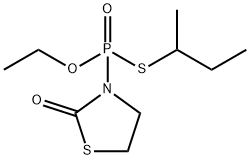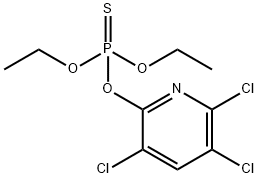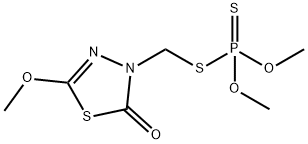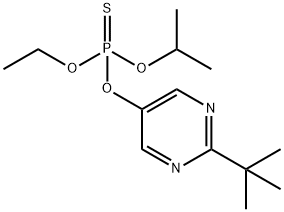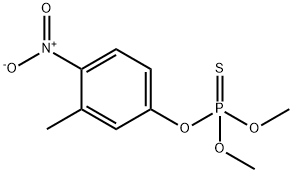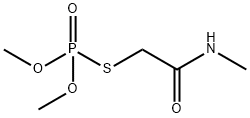CADUSAFOS
Synonym(s):O-Ethyl S,S-bis(1-methylpropyl) phosphorodithioate
- CAS NO.:95465-99-9
- Empirical Formula: C10H23O2PS2
- Molecular Weight: 270.39
- MDL number: MFCD00072511
- SAFETY DATA SHEET (SDS)
- Update Date: 2023-05-04 17:34:44
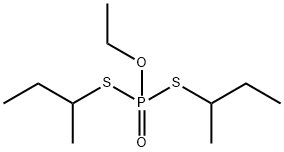
What is CADUSAFOS?
Description
This nonsystemic organophosphate not registered for U.S. usage is used to control nematodes and soil insects on bananas and other crops in several countries. The U.S. EPA has granted tolerances for cadusafos in imported bananas, where it provides excellent control of the burrowing nematode, Radopholus similis (22). Cadusafos reportedly possesses reduced risk for contaminating groundwater and provided good control of the citrus nematode, Tylenchulus semipenetrans (23). Cadusafos is commercially available in granular and microencapsulated formulations.
The Uses of CADUSAFOS
CADUSAFOS is used in the agriculture industry
The Uses of CADUSAFOS
Insecticide; nematocide.
The Uses of CADUSAFOS
Cadusafos is used to control nematodes, cutworms and soil insects in bananas, citrus, maize, potatoes, tobacco, sugar cane and vegetables.
Definition
ChEBI: Cadusafos is an organic thiophosphate and an organothiophosphate insecticide. It has a role as an EC 3.1.1.7 (acetylcholinesterase) inhibitor, a nematicide and an agrochemical.
General Description
Cadusafos is a nematicide used in controlling nematodes, soil insects and cutworms in a variety of fruits and vegetables. Its mode of action involves the inhibition of acetylcholinesterase.
Metabolic pathway
There is little published information on the metabolism of cadusafos. What has been published suggests that the main route of metabolism in animals is via hydrolysis to give 1-methyl-1-propanethiol which is then thiooxidised.
Metabolism
The acute oral LD50 values for rats and mice are 37.1 and 71.4 mg/kg, respectively. Inhalation LC50 (4 h) for rats is 0.026 mg/L air. NOEL (2 yr) for rats is 1 mg/kg diet (0.05 mg/kg/d) and ADI is 0.3 μg/kg. In mammals, it is readily metabolized and is eliminated in the urine and feces. The major metabolic route is hydrolysis to give 1-methyl-1-propanothiol, followed by oxidation. The halflife in soils is 11–55 d.
Properties of CADUSAFOS
| Melting point: | <25 °C |
| Boiling point: | 167°C |
| Density | 1.069±0.06 g/cm3(Predicted) |
| vapor pressure | 0.12 Pa (25 °C) |
| Flash point: | 129℃ |
| storage temp. | 2-8°C |
| form | neat |
| Water Solubility | 248 mg l-1 |
| Specific Gravity | 1.05 |
| BRN | 8140049 |
| EPA Substance Registry System | Cadusafos (95465-99-9) |
Safety information for CADUSAFOS
| Signal word | Danger |
| Pictogram(s) |
 Skull and Crossbones Acute Toxicity GHS06  Environment GHS09 |
| GHS Hazard Statements |
H400:Hazardous to the aquatic environment, acute hazard |
| Precautionary Statement Codes |
P262:Do not get in eyes, on skin, or on clothing. P273:Avoid release to the environment. P280:Wear protective gloves/protective clothing/eye protection/face protection. |
Computed Descriptors for CADUSAFOS
New Products
4-AMINO-TETRAHYDRO-PYRAN-4-CARBOXYLIC ACID HCL 4-(Dimethylamino)tetrahydro-2H-pyran-4-carbonitrile 4-Aminotetrahydropyran-4-carbonitrile Hydrochloride (R)-3-Aminobutanenitrile Hydrochloride 3-((Dimethylamino)methyl)-5-methylhexan-2-one oxalate 1,4-Dioxa-8-azaspiro[4.5]decane 5-Bromo-2-nitropyridine Nimesulide BP Aceclofenac IP/BP/EP Diclofenac Sodium IP/BP/EP/USP Mefenamic Acid IP/BP/EP/USP Ornidazole IP Diclofenac Potassium THOMAIND PAPER PH 2.0 TO 4.5 1 BOX BUFFER CAPSULE PH 9.2 - 10 CAP SODIUM CHLORIDE 0.1N CVS ALLOXAN MONOHYDRATE 98% PLATINUM 0.5% ON 3 MM ALUMINA PELLETS (TYPE 73) LITHIUM AAS SOLUTION 2-Bromo-1-(bromomethyl)-3-chloro-5-nitrobenzene 2-Bromo-3-nitroaniline N-(3-Hydroxypropyl)-N-methylacetamide 3-Bromo-6-chloropyridazine 4-ethyl-3-nitrobenzoic acidRelated products of tetrahydrofuran
You may like
-
 Cadusafos CAS 95465-99-9View Details
Cadusafos CAS 95465-99-9View Details
95465-99-9 -
 1-Methyl-6-oxo-1,6-dihydropyridazine-3-carbonitrile 98%View Details
1-Methyl-6-oxo-1,6-dihydropyridazine-3-carbonitrile 98%View Details
99903-60-3 -
 1823368-42-8 98%View Details
1823368-42-8 98%View Details
1823368-42-8 -
 2-(3-(tert-butyl)phenoxy)-2-methylpropanoic acid 1307449-08-6 98%View Details
2-(3-(tert-butyl)phenoxy)-2-methylpropanoic acid 1307449-08-6 98%View Details
1307449-08-6 -
 Ethyl 3-(furan-2-yl)-3-hydroxypropanoate 25408-95-1 98%View Details
Ethyl 3-(furan-2-yl)-3-hydroxypropanoate 25408-95-1 98%View Details
25408-95-1 -
 2-Chloro-5-fluoro-1-methoxy-3-methylbenzene 98%View Details
2-Chloro-5-fluoro-1-methoxy-3-methylbenzene 98%View Details
1805639-70-6 -
 1784294-80-9 98%View Details
1784294-80-9 98%View Details
1784294-80-9 -
 Lithium ClavulanateView Details
Lithium ClavulanateView Details
61177-44-4

